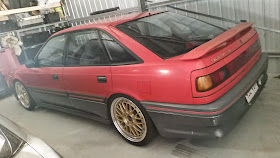The VIN (Vehicle Identification Number) and Build plates gives the identity and build details of any specific car. Today all manufactures us an International standard 17 digit VIN, which have codes to represent the World Manufacturer Identifier (WMI), Vehicle Descriptor Sector (VDS) and the Vehicle Identifier Section (VIS).
The International Standard VIN was not enforced until the 1st January 1989, when all vehicles sold in Australia needed a 17 digit VIN to be eligible for registration. Further information on this can be found at the following:
Mazda and Ford used a 17 digit VIN but it is not a standardised sequence as per other manufacturers. The AT models (built Oct 87 - Dec 89) have a 17 digit VIN and there is a lot of Ford produced technical references to support this, however the early AT TX5 Turbos did not use them.
This is out of my 1989 Workshop Repair Manual, showing the VIN type of the Australian Delivered cars and all other Right Hand Drive models.
Below is the breakdown for vehicles built for the Australian Market.
The Build plate is located on the bulk head of the Firewall. All Australian delivered AT/AV Telstars are all labeled as GD Models on the Build Plates. GD is the chassis designation for the Mazda equivalent. The AAA in the VDS is
described as being all vehicles produced from Nov 1991, however this identifier was used as early as 1989 as per below.
The JC0 and the AAA was not used on early AT TX5 Turbo model build plates. Instead they used the SHW as the VDS with the remained being the VIS as per the international standard.
The VIN can also be found stamped into the bulk head of the fire wall.
Below is a breakdown of an early AT TX5 Turbo VIN, indicating what each digit represents.
The Year and Month charts can be used to verify built dates. in the above example, J and C are the year and month as seen under Built Date.
This is an extract from the Ford Body Repair Quotation Guide and can be used to verify Build dates:
"The chart set out below interprets the production year and month codes. The letters I, O, Q and Z have been excluded from the system to avoid possible misinterpretation of similarity with other letters. The monthly codes set out as follows are recycled every fifth year."
 |
| from the Ford Body Repair Quotation Guide |
|
The Compliance plate is also located on the bulkhead of the fire wall, above the brake master cylinder and booster assembly. The ADR compliance plates were fitted to the vehicles once they had passed all requirements. It is not uncommon to see the compliance dates stamped a month after build date. They still retain the VIN as per the Built plate.
The AV Model build plates differ, in that they have the 17 digit VIN. The ADR Compliance plates also differ, in that they list the Approval number, the Category, but not the individual ADR numbers.
Below is an example of this as well as the build plate from my old 1990 TX5 Turbo.
If you would like me to decipher your VIN/ Build plates, feel free to contact me.










































